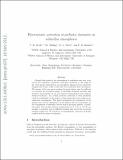Files in this item
Electrostatic activation of prebiotic chemistry in substellar atmospheres
Item metadata
| dc.contributor.author | Stark, Craig Ronald | |
| dc.contributor.author | Helling, Christiane | |
| dc.contributor.author | Diver, Declan A | |
| dc.contributor.author | Rimmer, Paul | |
| dc.date.accessioned | 2014-01-13T11:01:03Z | |
| dc.date.available | 2014-01-13T11:01:03Z | |
| dc.date.issued | 2014-04 | |
| dc.identifier | 89935463 | |
| dc.identifier | 3fc9c8a8-b3f9-4c1f-990c-c43140228949 | |
| dc.identifier | 84898768413 | |
| dc.identifier | 000333749700009 | |
| dc.identifier.citation | Stark , C R , Helling , C , Diver , D A & Rimmer , P 2014 , ' Electrostatic activation of prebiotic chemistry in substellar atmospheres ' , International Journal of Astrobiology , vol. 13 , no. Special Issue 2 , pp. 165-172 . https://doi.org/10.1017/S1473550413000475 | en |
| dc.identifier.issn | 1473-5504 | |
| dc.identifier.other | ArXiv: http://arxiv.org/abs/1311.4408v1 | |
| dc.identifier.uri | https://hdl.handle.net/10023/4358 | |
| dc.description.abstract | Charged dust grains in the atmospheres of exoplanets may play a key role in the formation of prebiotic molecules, necessary to the origin of life. Dust grains submerged in an atmospheric plasma become negatively charged and attract a flux of ions that are accelerated from the plasma. The energy of the ions upon reaching the grain surface may be sufficient to overcome the activation energy of particular chemical reactions that would be unattainable via ion and neutral bombardment from classical, thermal excitation. As a result, prebiotic molecules or their precursors could be synthesised on the surface of dust grains that form clouds in exoplanetary atmospheres. This paper investigates the energization of the plasma ions, and the dependence on the plasma electron temperature, in the atmospheres of substellar objects such as gas giant planets. Calculations show that modest electron temperatures of $\approx 1$ eV ($\approx 10^{4}$ K) are enough to accelerate ions to sufficient energies that exceed the activation energies required for the formation of formaldehyde, ammonia, hydrogen cyanide and the amino acid glycine. | |
| dc.format.extent | 18 | |
| dc.format.extent | 209961 | |
| dc.language.iso | eng | |
| dc.relation.ispartof | International Journal of Astrobiology | en |
| dc.subject | astro-ph.EP | en |
| dc.subject | Dust | en |
| dc.subject | Exoplanets | en |
| dc.subject | Prebiotic Chemistry | en |
| dc.subject | Plasmas | en |
| dc.subject | QB Astronomy | en |
| dc.subject.lcc | QB | en |
| dc.title | Electrostatic activation of prebiotic chemistry in substellar atmospheres | en |
| dc.type | Journal article | en |
| dc.contributor.sponsor | Science & Technology Facilities Council | en |
| dc.contributor.sponsor | European Research Council | en |
| dc.contributor.institution | University of St Andrews. School of Physics and Astronomy | en |
| dc.identifier.doi | 10.1017/S1473550413000475 | |
| dc.description.status | Peer reviewed | en |
| dc.identifier.grantnumber | ST/J001651/1 | en |
| dc.identifier.grantnumber | 257431 257431 | en |
This item appears in the following Collection(s)
Items in the St Andrews Research Repository are protected by copyright, with all rights reserved, unless otherwise indicated.

